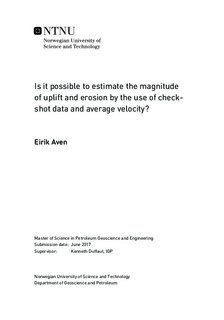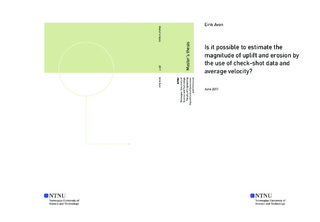| dc.description.abstract | This work investigates a new method in quantifying the magnitude of net erosion or net exhumation by using average velocity profiles derived from check-shot data. The fundamental principle is based on finding the same average lithology in both uplifted and not uplifted regions. Thus, if two large intervals are found, which have comparable average properties, then they can be used for net exhumation estimates despite consisting of composite lithology. Using a larger lithological interval and average velocity are considered to bear less uncertainty. An essential part of the method revolves around using similar velocity-depth gradients for the uplifted area and not uplifted area, which in turn is believed to be important for accurate net exhumation estimates.
The new methodology is applied on 7 wells in the Barents Sea, then compared to results from standard shale compaction trends using density and sonic well logs. The net exhumation estimates from average velocity are considerably lower than those of sonic (100m-750m less ~ average 450m less), and slightly lower than those of density (-150m-650m less ~ average 200m less). The high net exhumation estimates from the sonic logs might be due to overpressure mainly affecting the sonic log and not the density log. Average velocity might be robust with respect to overpressure, since its believed to correct for such effects when finding the same average lithology/acoustic properties. The check-shot method is also advantageous to use when a lithology is missing/thin since it does not utilize a specific rock type, but instead it uses a larger lithological interval. The methods show steady increase in net exhumation from SW to NE, but the sonic/density show more spiky results possibly due to the smaller depth interval being used, along with varied density/velocity-depth gradients and uncertainty related to lithological control. The main uncertainty for the check-shot method is possibly related to establishing the relevant parameters for the reference trend, and understanding the validity of some assumptions. More research should be done to test the method and the underlying principles. However, if the lower net exhumation estimates are more correct than the those from sonic/density; areas earlier thought to be unfavorable could be reconsidered for further exploration. This work represents an exciting and important front for further work, as using average velocity has not been common to use, and it has widespread availability in seismic data. | |

